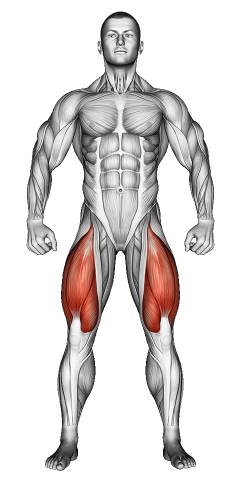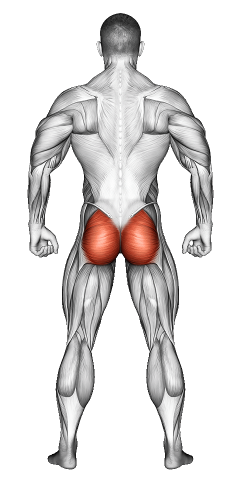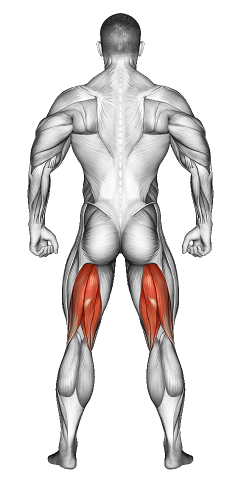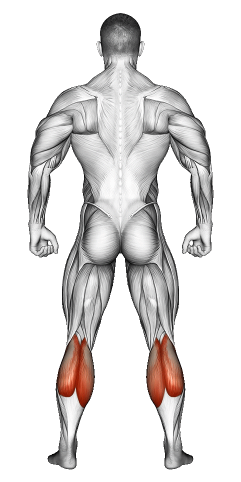Jump Squats: Video Tutorial & Exercise Guide

Written By: Claude Michael
Updated: Dec 26, 2024
| Workout | Jump Squats |
| Primary Muscle Group | Quads |
| Secondary Muscle Group | Glutes, Hamstrings, Calves |
| Equipment Required | None |
| Force Type | Push |
| Mechanics | Compound |
| Exercise Type | Lower Body and Cardio |
| Difficulty | Beginner to Intermediate |
Jump Squats: Video Tutorial & Exercise Guide
Secondary Muscles Group
Jump Squats: Step-by-Step Guide
- Step 1: Stand with your feet shoulder-width apart and your toes pointing slightly outward. Engage your core, keep your chest up, and get ready to squat down. This setup lets you move with power and control.
- Step 2: Squat down by bending your knees and pushing your hips back. Keep your weight in your heels, and lower until your thighs are parallel to the floor. Feel your quads and glutes activate as you sink down.
- Step 3: Drive through your heels and jump up explosively. Swing your arms up as you jump to add momentum, aiming to jump as high as possible. Keep your core tight to stay balanced.
- Step 4: Land softly on the balls of your feet, then lower your heels to absorb the impact. Immediately return to the squat position, keeping your knees bent. Landing softly protects your knees and gets you ready for the next jump.
- Step 5: Repeat the jump and squat sequence in a smooth rhythm. Focus on height with each jump and control in each squat. Keep the movement powerful and steady.
- Step 6: Breathe in as you lower into the squat, and breathe out as you jump up. Controlled breathing keeps your energy steady and helps each jump feel strong.
Jump Squats: Overview
Jump Squats build strength and cardio power, making them perfect for a fast, effective lower-body workout. They target your quads, glutes, and calves, building explosive strength while boosting your heart rate. This move improves balance, coordination, and power, giving you a full-body boost without any equipment.
Jump Squats: Benefits
Jump Squats strengthen your legs, increase your power, and improve cardiovascular fitness. This exercise targets multiple muscle groups at once, adding intensity to your workout and burning calories. Jump Squats improve athletic performance, build lower body endurance, and support better balance and stability.
Jump Squats: Pro Tips & Advanced Techniques
- Land Lightly: Focus on a soft landing to reduce impact on your knees and joints. This controlled landing lets you go straight into the next jump.
- Engage Your Core: Tighten your core throughout the exercise to help you jump higher and keep your posture strong.
- Go Deeper in the Squat: Lower a bit deeper in the squat before jumping to increase the challenge and target your glutes.
- Breathe with Control: Inhale as you squat, exhale as you jump. This breathing pattern keeps your rhythm steady and supports your power.
Jump Squats: Progression Plan
Beginner
Intermediate
Advanced
Jump Squats: Frequently Asked Questions (FAQs)
What muscles do Jump Squats work?
+Jump Squats target your quads, glutes, hamstrings, and calves, giving you a full lower body workout with a cardio element.
Can I add Jump Squats to any workout?
+Yes! Jump Squats fit well as a warm-up, cardio burst, or finisher on leg day.
Do Jump Squats improve athletic performance?
+Absolutely. Jump Squats build leg power and explosive strength, which improve agility, balance, and speed.
How often should I do Jump Squats?
+Add them to your workout routine 2-3 times a week for steady progress in strength and endurance.
What mistakes should I avoid?
+Avoid landing too hard, letting your knees cave in, or losing balance. Stay controlled, keep your core tight, and focus on smooth, powerful jumps for the best results.
Share
Don’t Wish for It, Work for It – Join the FlexXP Newsletter Today!
Thank you for signing up for the FlexXP Newsletter!
This site is protected and the Google Privacy Policy and Terms of Service apply.



